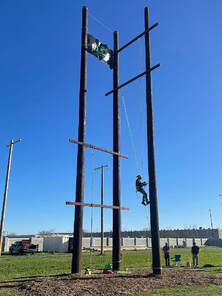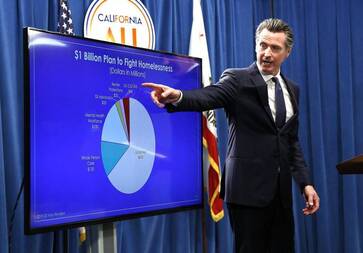Three areas where philanthropic funders can partner with government on infrastructure investments to advance equity in the United States. This article originally appeared in Stanford Social Innovation Review. Over the past several months I have received calls from dozens of philanthropic leaders eager to help ensure that the trillions of dollars flowing to US communities through the federal Infrastructure and Jobs Investment Act reach the country’s most vulnerable communities. But they often don’t know where their dollars will make the most impact. While building things like roads and bridges or providing clean water is traditionally the work of government, public-philanthropic partnership provides a framework to ensure that local, state, and federal governments work closely with community-based organizations and philanthropic entities so that government funding actually serves people’s needs and lays the groundwork for lasting, equitable change. The good news is that we have strong models for governing in partnership with the philanthropic sector to support local communities and scale impact at all levels of government. In cities across the country, Bloomberg Associates’ Collaborative Cities initiative, for example, is seeding partnerships between the public, private, and nonprofit sectors to help cities creatively tackle social issues. The initiative helps different partners marshal resources, coordinate responses, and leverage the unique assets each brings to the table. In Michigan, the Office of the Foundation Liaison has an 18-year track record of forging partnerships between state government and the philanthropic sector to encourage programs or policy reforms that would improve the lives of residents. And in California, Governor Newsom has led 42 public-philanthropic partnerships leveraging more than $4 billion in private funding to advance policy priorities like addressing homelessness and fighting the COVID-19 pandemic. Based on the dozens of public-private partnerships we’ve led in California, we see three areas where philanthropic funders would do well to invest now: 1. Civic Infrastructure Through Community Capacity Building While the majority of the focus on the infrastructure bill has been on roads, bridges, and broadband, one major opportunity that often gets overlooked is the chance to invest in civic infrastructure. Philanthropy is well-poised to support the capacity building of local organizations so that they can build the strength and voice they need to effectively represent community interests, not just now but for the long run. This kind of cross-sector collaboration was a force behind our efforts to count all Californians in the 2020 census. The state worked with foundations to invest a combined $130 million in supporting community-based organizations (CBOs) so that they could reach people of color, as well as disabled, low-income, and other traditionally hard-to-count communities. We took worked with CBOs to do door knocking, calls, and outreach events, targeting zip codes where people were at-risk of not being counted. As the census wrapped up, COVID-19 vaccines were just getting approved, so we doubled down on our partnerships with these organizations to reach those same less-resourced communities. As of the end of this year, our partnerships with Public Health Institute’s Together Toward Health Initiative, Sierra Health Foundation’s Vaccine Equity Campaign, and California Community Foundation have channeled more than $100 million to more than 700 CBO partners, reaching people in all of California’s 58 counties to educate them about the importance of getting vaccinated and provide support with vaccine appointments. Now is the time to build on networks of local partners to ensure that infrastructure spending is distributed equitably. For example, our office is developing a partnership between the California Natural Resources Agency Water Foundation and the Water Foundation and Water Funders Initiative to build community power and capacity to benefit from public funding, support water leaders who can represent community priorities, and support systemic solutions by aligning relief efforts with long-term strategies such as infrastructure investments. In the coming months and years, state and local agencies across the United States will be distributing trillions of dollars that community-based organizations often can’t access, because they are too small to apply for complicated public funding grants. Philanthropic investments can help ensure that these organizations don’t end up on the sidelines by supporting their capacity to help influence how funding is distributed. 2. Technical Assistance State and local agencies now tasked with implementing major expansions of programs like the child tax credit, broadband, and public transit projects will need to bring on more staff to distribute infrastructure funding within the bill’s time constraints. And state employees aren’t always in the best position to get out into communities to ensure that they are aware of these programs and how to participate. Philanthropic partnership can help provide the technical assistance agencies need to both ramp up their programs and to ensure that communities are part of the program design from the start. One example is a partnership we developed in California to support technical assistance for workforce development organizations. The High Road Training Partnerships (HRTP) program, managed by the state Workforce Development Board (CWDB), supports high-quality jobs by funding collaboration between private employers, local community-based organizations, and labor. HRTP collaborations develop high-quality opportunities in targeted industries, get workers jobs, and enable them to develop stability in those jobs. Partnerships like these are critical in the context of infrastructure, where for every billion spent, an estimated 20,000 jobs are created. This year, the state invested $100 million to expand the HRTP program, and CWDB has partnered with Jobs for the Future—a national nonprofit that drives change in workforce and education systems—to create technical assistance microgrants that cover pre-application costs and help CBOs and other small organizations apply for the funding. Additionally, the Community Economic Resilience Fund, a $600 million state fund to support regional economic development planning in 13 regions in California, is a huge opportunity to build jobs for the future and develop inclusive, sustainable local economies. Philanthropic partners led by the James Irvine Foundation have come together to support mapping of existing community efforts and facilitation by California Forward, a statewide economic development organization, and PolicyLink, a national institute to advance racial and economic equity, to ensure that communities have the resources to put inclusion and racial equity at the center of these plans. By working in partnership with the state to support these types of technical assistance, philanthropy can help give vulnerable communities greater agency in determining how to spend the influx of public dollars, having potential impact for generations to come. 3. Research and Evaluation Philanthropic organizations have a long tradition of supporting research and evaluation in partnership with government, but with so much public funding at play, this is a moment to scale innovative policies and programs like never before. But making these programs sustainable requires that we develop strong data and evaluation practices to determine whether they are actually having an impact. Philanthropic partners are well poised to support evaluation efforts which could be used to improve these initiatives and advance policy advocacy for future programming. For example, during the early days of the pandemic, we launched an initiative called Project Roomkey to house 50,000 unsheltered people in hotels and motels across the state rather than in congregate shelters. The program is potentially game-changing for our ability to house Californians in the long run, but to prove its full impact, California Health Care Foundation and Hilton Foundation are working together with the California Health and Human Services Agency to evaluate it, with a specific focus on the health impacts of providing housing and services. Philanthropic leaders should examine opportunities to partner with state and local agencies to ensure that research and evaluation are built into infrastructure spending from the start, as opposed to being an afterthought. We must not let this historic moment go to waste. With trillions of dollars flooding state and local agencies over the next several years, philanthropic partners can and should find ways to ensure that those dollars are truly reaching the communities that need it most. If that happens, we will be able to look back and know that this was a moment when America reversed the tide of inequity in our society.
0 Comments
 This article by Kathleen Kelly Janus and Marciela Rodriguez originally appeared in the Press Enterprise. In March of this year, President Biden told Americans that vaccinations would allow us to celebrate July 4 with neighborhood cookouts. Four months later, California became one of 18 states to reach the White House milestone of vaccinating 70% of our eligible population. While reaching this goal made Independence Day celebrations possible, it is the strong community partnerships that have been built by vaccinating over 20 million Californians that promise to have lasting effects long after this pandemic is over. Before the goal was met, the community infrastructure created by those of us in state operations was essential for conducting one of the most comprehensive census count efforts in history: Census 2020. In the middle of it, we had to adjust when COVID-19 struck so we could deliver nearly 50 million COVID vaccinations. Both operations provided critical lessons that will help prepare us for the next stage of economic recovery. At the heart of these efforts sits a robust community organizing model. In California, we’ve seen first-hand that community engagement isn’t just about helping; it’s about hearing from people first, then responding to their needs. California’s 2020 Census and vaccination efforts center on a data-driven approach that prioritizes hard-to-count communities. With a state as big and diverse as California, partnerships outside of government also are necessary. During the lead up to the census, hundreds of local CBOs were engaged. The $130 million public-private partnership invested in promotoras—health workers in the Latino community—and other community organizers. These trusted messengers not only mitigated the fear families were facing from harsh anti-immigration rhetoric and policies, they also lifted up the voices of those who have historically been marginalized. Census details included meetings with nonprofit leaders, held regularly to share best practices and address barriers that existed across different communities. This coordination became critical when the pandemic hit in early 2020, forcing the entire outreach operation to shift away from planned in-person events and activities. Pivoting when COVID-19 hit was challenging but successful, thanks to the strong foundation of trusted relationships and community infrastructure that had been established. Once vaccines were proven safe and effective for distribution, California built on the Census community outreach infrastructure, establishing a vaccine equity framework and an all-hands-on-deck outreach effort to vaccinate those who were disproportionately impacted by the pandemic. We tapped many of our top census partners throughout California and funded them to do COVID-19 outreach and vaccine appointment assistance. We worked with philanthropic partners like The Center at Sierra Health Foundation, the California Community Foundation and the Public Health Institute Together Toward Health Initiative, and additional CBOs. Their collaborative work often led to additional and desperately needed funding of community-based pop-up vaccine clinics, staffing and transportation. These efforts are playing out in communities throughout California and will be critical to reaching our vaccine equity goals. Take the work of Leadership Counsel for Justice and Accountability (LCJA) in Lanare, Calif., to connect rural farmworkers with vaccines. Over the past few months LCJA helped provide over 1,000 vaccines to communities in partnership with local public health leaders with door-to-door canvassing, phone calls, and bilingual registration to reduce barriers to participation. In the Inland Empire, El Sol Neighborhood Educational Center delivered nearly 6,000 vaccinations and 7,000 COVID-19 personal care kits to increase protection in California’s most vulnerable communities. El Sol was recently recognized by President Biden at a White House celebration and honored as a Nonprofit of the Year by the California Association of Nonprofits. We don’t claim to have everything figured out when it comes to community engagement, and we continuously seek to do better. But there is no doubt that we know how to leverage the strengths of the public and private sectors to strengthen our efforts. As we get closer to ending this pandemic, we will continue listening to people from our communities as they talk about what they need for jobs, housing, health care and other inequities we face, and partner with the many essential community-based organizations in California to meet those needs. 6/22/2019 0 Comments California faces multiple crises. Can we solve them without help from philanthropy? This article originally appeared in the Sacramento Bee. California is no stranger to crisis. Nearly 20 years ago, when we were experiencing rolling blackouts across the state and the fallout after the dotcom bubble burst, the governor invited nonprofits and philanthropists to join him in solving the most pressing social problems of the day. But philanthropy was wary of getting too close to government, and government quickly became too distracted with the energy crisis to cultivate meaningful partnerships with philanthropy. Today, skyrocketing housing costs are forcing Californians out of their communities and onto the streets, our education system ranks among the lowest in the nation and more than a million Californians don’t have clean drinking water. We are in the middle of a mess in our state. But, today, the sector has changed. We are finally willing to admit that we need each other. California is the land of innovation. But that innovation does not need to be confined to the tech giants of Silicon Valley, the biotech labs of San Diego or the entertainment masterminds of Los Angeles. We have the opportunity to marry California’s innovative spirit with state government and, in doing so, help solve many of our greatest and most pressing social issues. In fact, many of our greatest innovators are hard at work in local communities solving the most pressing social problems we face. In October of 2017, when the fires ravaged Sonoma County, leaving hundreds of people without homes, La Luz Center in Sonoma didn’t just rebuild housing. They saw it as an opportunity to train low-income workers in the construction trade. In the Bay Area, Doniece Sandoval, the founder of Lava Mae, developed a network of mobile showers for the homeless, using “radical hospitality” to give their guests dignity, a first step in rebuilding their lives. And in Stockton, Mayor Michel Tubbs guaranteed 100 low-income residents $500 a month to see if a system of universal basic income might alleviate some of the daily shocks of living in poverty. People are coming together across sectors like never before to address long-standing problems. In a recent census convening in Sacramento coordinated by Philanthropy California – a statewide collaboration of grantmakers – every square inch of the room was packed with community leaders, philanthropists and government officials. It was so crowded that people were literally sitting on the floor, taking notes. Together, they are devising a shared strategy to count every Californian in the 2020 census and avoid the billions of dollars in lost federal funding as a result of undercounting in the past. In Los Angeles, the California Community Foundation is pulling from its endowment and partnering with foundations, developers and lenders to help ensure LA County is successful in its commitment to more than triple the production of affordable housing and support services to keep low-income populations housed. Gov. Gavin Newsom has once again invited philanthropists, social entrepreneurs and CEOs to be part of his agenda for change in California, and this time the response has been overwhelming. As I step into the first-ever role as senior adviser on social innovation for Newsom, I am committed to elevating stories of social change from every community and building strong multi-sector partnerships across our state. Private philanthropy is nimble enough to invest in research and development, while government has the unique power to purchase and scale new solutions. And of course none of that matters without strong nonprofits on the ground who are implementing services, welcoming clients through their doors and being responsive to their lived experiences. In order for us to move through the crisis we’re seeing in California, we have to ensure that we are not only investing in service to our communities but acting as a unified driver of growth, change and justice for all.  Over the past five years I’ve traveled the country talking with top-performing nonprofit leaders about the key to their growth, the results of which will be featured in my forthcoming book, Social Startup Success. One answer that came up time and time again was the importance of a strong board of directors. More than strategy or guidance, the most successful organizations relied on their boards to raise money for them. The research also showed that many nonprofit leaders are frustrated with their boards’ failure to generate more contributions. For example, in my survey of over 250 nonprofit social entrepreneurs around the country, only 15 percent reported their boards were involved in fundraising, with 66 percent saying they wished their board would help more on fundraising. This is a huge disconnect. Here’s a step-by-step guide for how to get your nonprofit board to step up its fundraising: 1.Set the priorities early. During the recruitment process, nonprofit leaders often shy away from emphasizing the fundraising aspect of the board role for fear of scaring away potential candidates. As a result, they end up with a group of board members who may not even realize that fundraising is part of a job. If you want your board to fundraise, it’s important that you include this in the job description. Have a conversation with potential board members about how much money you expect to raise annually and make sure they are on board with that plan. 2.Make sure that your board policy is explicit. Once board members sign on, you should require them to sign a board policy that spells out clearly each board member’s annual fundraising obligation. How much will they be required to personally give? How much will they be required to raise? Engage your board members in developing these requirements so that you ensure that you have their buy-in and support. 3.Support board members in their fundraising efforts. Even if board members realize that there is an expectation to fundraise, they may not have the tools they need to do so. Hosting an annual “how to make an ask” training with your development director is one way to get board members up to speed. You can even provide a “cut and paste” email for board members to send to potential donors to make their job as easy as possible. 4.Create a variety of entry points. Everyone likes to get involved in different ways, so it is also important that you provide board members with a buffet of opportunities to fundraise and get their friends involved – events where they can invite potential donors, regular updates by email and an open door policy to take potential donors out to lunch to tell them more about the organization. 5.Hold board members accountable. One of the biggest deterrents to creating a strong culture of fundraising on your board is a lack of follow through. If even just one or two people don’t meet their fundraising goals, it can bring down the enthusiasm of the entire board. It’s important that nonprofit leaders keep tabs on their board members throughout the year so that they can support those who aren’t meeting expectations, and be prepared to have the hard conversation to let board members go when they don’t follow through. Importantly, following these steps improves the situation for everyone. Executive directors will be less frustrated, relieving the 66% of those who wished their board stepped up more in fundraising, the board of directors will have clearer, more impactful goals, and it will also result in a boost in funding for nonprofits, which ultimately increases social impact. |
|
 RSS Feed
RSS Feed